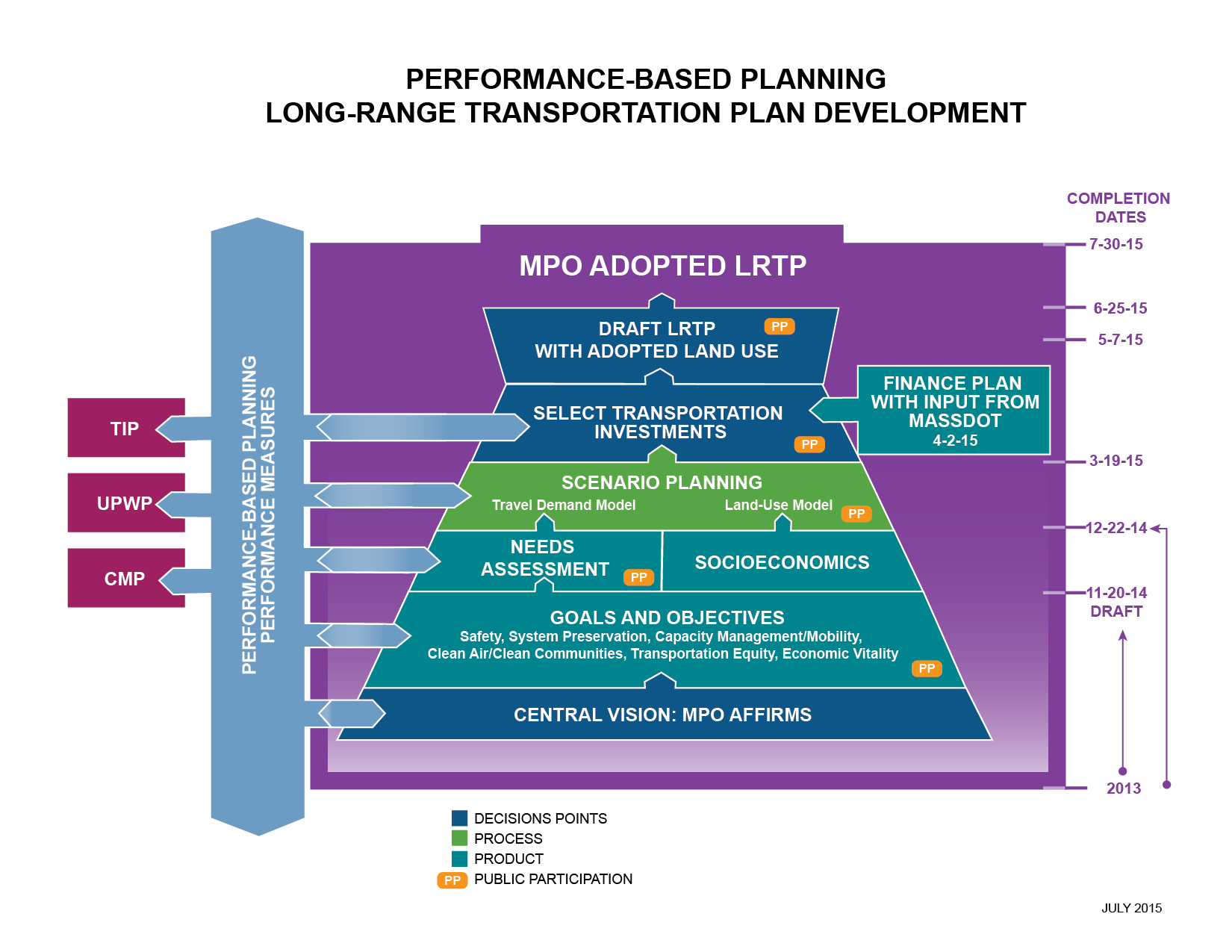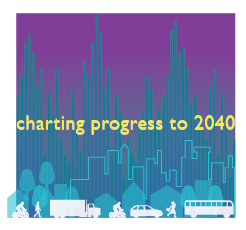
CHARTING PROGRESS to 2040:
The Boston Region’s Next Long-Range Transportation Plan
Metropolitan Boston Region
Summer 2015
The Boston Region Metropolitan Planning Organization (MPO) adopted its Long-Range Transportation Plan (LRTP), Charting Progress to 2040, which provides a 25-year vision for transportation in the Boston metropolitan area. In this plan, the MPO sets priorities for future federally-funded transportation planning studies and capital-improvement projects.
The LRTP development process consisted of several steps:
- Established a vision, goals, and objectives for future transportation investments in the Boston region
- Identified the region’s transportation needs through assessing existing conditions
and transportation system’s performance, and identifying issues to address in the future
- Conducted scenario planning to consider investment strategies that will advance the region’s transportation goals
- Developed a plan that accounts for expected transportation funding over the next 25 years, analyzed the greenhouse gas, air quality, and environmental justice impacts of the plan, and circulated the plan for public review and comment
The public played a key role in shaping transportation for the next 25 years. The MPO sought public feedback throughout the development of the long-range transportation plan.
1 ESTABLISH VISION, GOALS, AND OBJECTIVES
First the MPO established a vision for transportation in the region. It set goals and
objectives to:
- Guide the project and program selection process for the LRTP and Transportation Improvement Program (TIP)
- Guide MPO studies in the Unified Planning Work Program (UPWP)
- Monitor and evaluate the transportation system in the future
Vision
The Boston Region Metropolitan Planning Organization envisions a modern transportation
system that is safe, uses new technologies, provides equitable access, excellent mobility, and varied transportation options—in support of a sustainable, healthy, livable, and economically vibrant region.
Goals and Objectives
The MPO’s goals and objectives are shown in the table below.
Please give us your feedback!
- Do the MPO’s vision, goals, and objectives for transportation in the region align with the region’s transportation priorities?
- Which of the MPO goals and objectives are most important to the region
- Is there anything missing from the goals and objectives?
The MPO welcomes your input on the LRTP process, particularly with regard to the questions listed throughout this document. Please visit the Charting Progress to 2040 page on the MPO’s website (www.bostonmpo.org/Drupal/charting_2040) to learn more about the LRTP process and provide your comments.
Central Vision Statement
The Boston Region Metropolitan Planning Organization envisions a modern transportation system that is safe, uses new technologies, provides equitable access, excellent mobility, and varied transportation
options—in support of a sustainable, healthy, livable, and economically vibrant region.
REVISED GOALS AND OBJECTIVES - March 19, 2015
SAFETY: Transportation by all modes will be safe
- Reduce number and severity of crashes, all modes
- Reduce serious injuries and fatalities from transportation
- Protect transportation customers and employees from safety and security threats
(Note: The MPO action will be to incorporate security investments into capital planning.)
SYSTEM PRESERVATION: Maintain the transportation system
- Improve condition of on- and off-system bridges
- Improve pavement conditions on MassDOT-monitored roadway system
- Maintain and modernize capital assets, including transit assets, throughout the system
- Prioritize projects that support planned response capability to existing or future extreme conditions (sea level rise, flooding, and other natural and security-related man-made hazards)
- Protect freight network elements, such as port facilities, that are vulnerable to climate-change impacts
CAPACITY MANAGEMENT/MOBILITY: Use existing facility capacity more efficiently and increase healthy transportation capacity
- Improve reliability of transit
- Implement roadway management and operations strategies, constructing improvements to the bicycle and pedestrian network, and supporting community-based transportation
- Create connected network of bicycle and accessible sidewalk facilities (at both regional and neighborhood scale) by expanding existing facilities and closing gaps
- Increase automobile and bicycle parking capacity and usage at transit stations
- Increase percentage of population and places of employment within one-quarter mile of transit stations and stops
- Increase percentage of population and places of employment with access to bicycle facilities
- Improve access to and accessibility of transit and active modes
- Support community-based and private-initiative services and programs to meet last mile, reverse commute and other non-traditional transit/transportation needs, including those of the elderly and persons with disabilities
- Eliminate bottlenecks on the freight network
- Enhance intermodal connections
- Emphasize capacity management through low-cost investments; give priority to projects that focus on lower-cost O&M-type improvements such as intersection improvements and Complete Streets solutions
CLEAN AIR/CLEAN COMMUNITIES: Create an environmentally friendly transportation system
- Reduce greenhouse gases generated in the Boston region by all transportation modes as outlined in the Global Warming Solutions Act
- Reduce other transportation-related pollutants
- Minimize negative environmental impacts of the transportation system
- Support land use policies consistent with smart and healthy growth
TRANSPORTATION EQUITY: Provide comparable transportation access and service quality among communities, regardless of income level or minority population
- Target investments to areas that benefit a high percentage of low-income and minority populations
- Minimize any burdens associated with MPO-funded projects in low-income and minority areas
- Break down barriers to participation in MPO-decision making
ECONOMIC VITALITY: Ensure our transportation network provides a strong foundation for economic vitality
- Respond to the mobility needs of the 25–34-year-old workforce
- Minimize the burden of housing and transportation costs for residents in the region
- Prioritize transportation investments that serve targeted development sites
- Prioritize transportation investments consistent with the compact-growth strategies of MetroFuture
2 IDENTIFY TRANSPORTATION NEEDS
Next, the Boston Region MPO conducted a Needs Assessment to identify transportation needs within the MPO’s goal areas, which include but are not limited to, safety, congestion reduction, and transportation options. The Needs Assessment features a Web-based application that displays data on high crash locations, congested roadways, and walking, biking and transit coverage, along with data on
other topics.The tool can be accessed at www.bostonmpo.org/drupal/charting_2040_needs. The MPO used this information to guide development of investment strategies to address these needs.
The maps and data below reflect some of the needs that MPO staff identified through the Needs Assessment process. For example, bottlenecks in the roadway system cause congestion and accidents and result in higher emissions of pollutants. MPO staff analyzed crash data and congestion information from the Needs Assessment to cite bottleneck locations with severe congestion and high crash severity in the Boston region.
Highway Bottlenecks
- Route 128 at Lowell Street (Exit 26) in Peabody
- I-93 between the Braintree Split and the Massachusetts Ave. Interchange
- I-90 between Interchanges 16 and 17 in Newton
- I-93 between I-95 in Woburn and the Leverett Connector
- I-95 between I-93 in Woburn and US 1 in Lynnfield
Arterial Bottlenecks
- Route 114 in Peabody and Salem
- Route 1A in Revere
- Route 16 from Cambridge to Revere
- Route 60 from Route 2 to Route 2A and Medford St. in Arlington
- Route 129 Wilmington to Reading
- Route 3A Marshfield to Quincy
- Route 16 from Holliston to Newton
- Route 28 Milton to Randolph
- Route 138 in Canton and Milton
- Route 9 Southborough to Newton
- Route 20 (Weston)
- Route 30 between I-90 and Route 9 (Framingham)
- Route 135 Wellesley to Natick
- Routes 62, 225 and 4 corridor in Bedford and Lexington
- Route 2 Bypass Road/Cambridge Turnpike to Piper Road/Taylor Road in Concord and Acton
Congestion on Highways by Planning Time Index
This map displays congestion on highways by planning time index. Planning time index measures the reliability of congestion based on the ratio of the 95th percent peak-period travel time to the free-flow travel time.
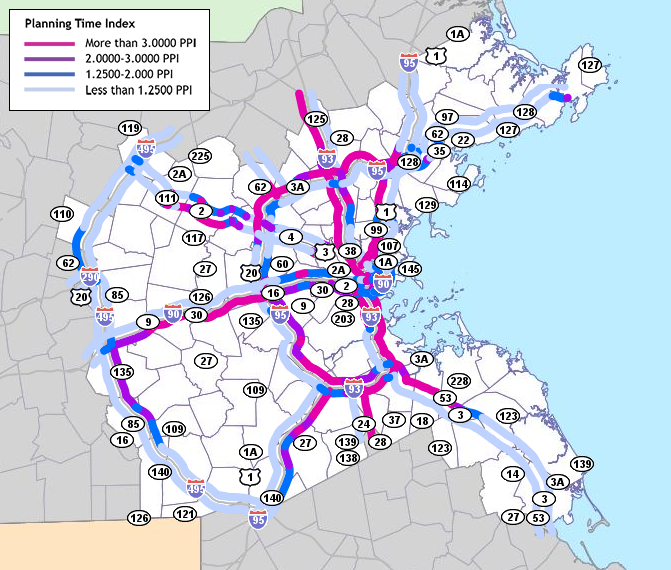
High Crash Locations by Equivalent Property Damage Only
This map displays high crash locations by equivalent property damage only (EPDO). EPDO measures crash severity based on property damage, personal injuries, and fatalities.
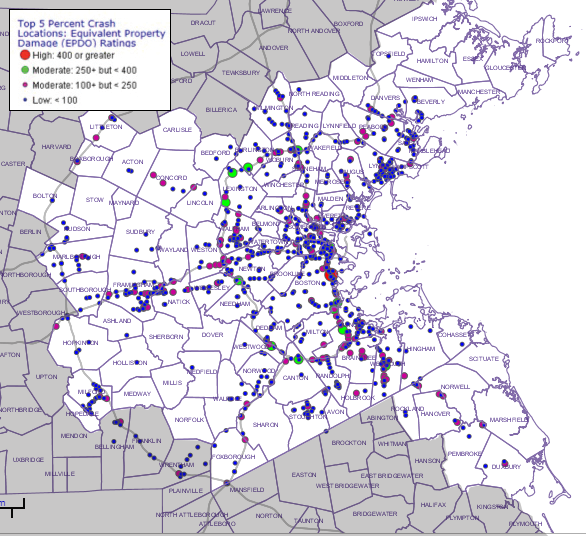
High Priority Bike Gaps
- Massachusetts Central Trail in Waltham
- Upper Charles Trail in Framingham/Ashland/Sherborn
- Community Path/Greenline Extension in Somerville
- Sudbury Aqueduct Trail in Framingham
- Dorchester Connector in Boston
- Boston University bridge to Emerald Necklace in Boston
- Minuteman to Mystic Valley in Arlington
- Central Square in Cambridge
- Charlesgate in Boston
- Commuter Rail to East Boston Greenway in Chelsea
- Canal Street Bikeway in Salem
Transit Gaps
- Very densely populated areas in Lynn, Chelsea, Everett, and Medford, which generate significant numbers of trips into the urban core, do not have frequent rapid transit access within a reasonable walking distance.
- Very densely populated areas in Roxbury and Dorchester served by MBTA bus Routes 23 and 28 do not have frequent rapid transit access within a reasonable walking distance. Travel times on these routes are long and unreliable.
- Although the MBTA currently operates some circumferential bus connections between rapid transit spokes, buses must compete with cars on increasingly congested urban streets, reducing the appeal of these services. More frequent, circumferential, rapid, and through routed connections would greatly enhance mobility between Central Area activity centers, as well as in the Route 128 corridor and other important destinations.
Regional High Priority Bike Gaps
This map displays the high priority bike gaps in the regional bike network as prioritized by access to underserved communities, employment centers, town centers, central business districts, schools, universities/colleges, and parks or open space.
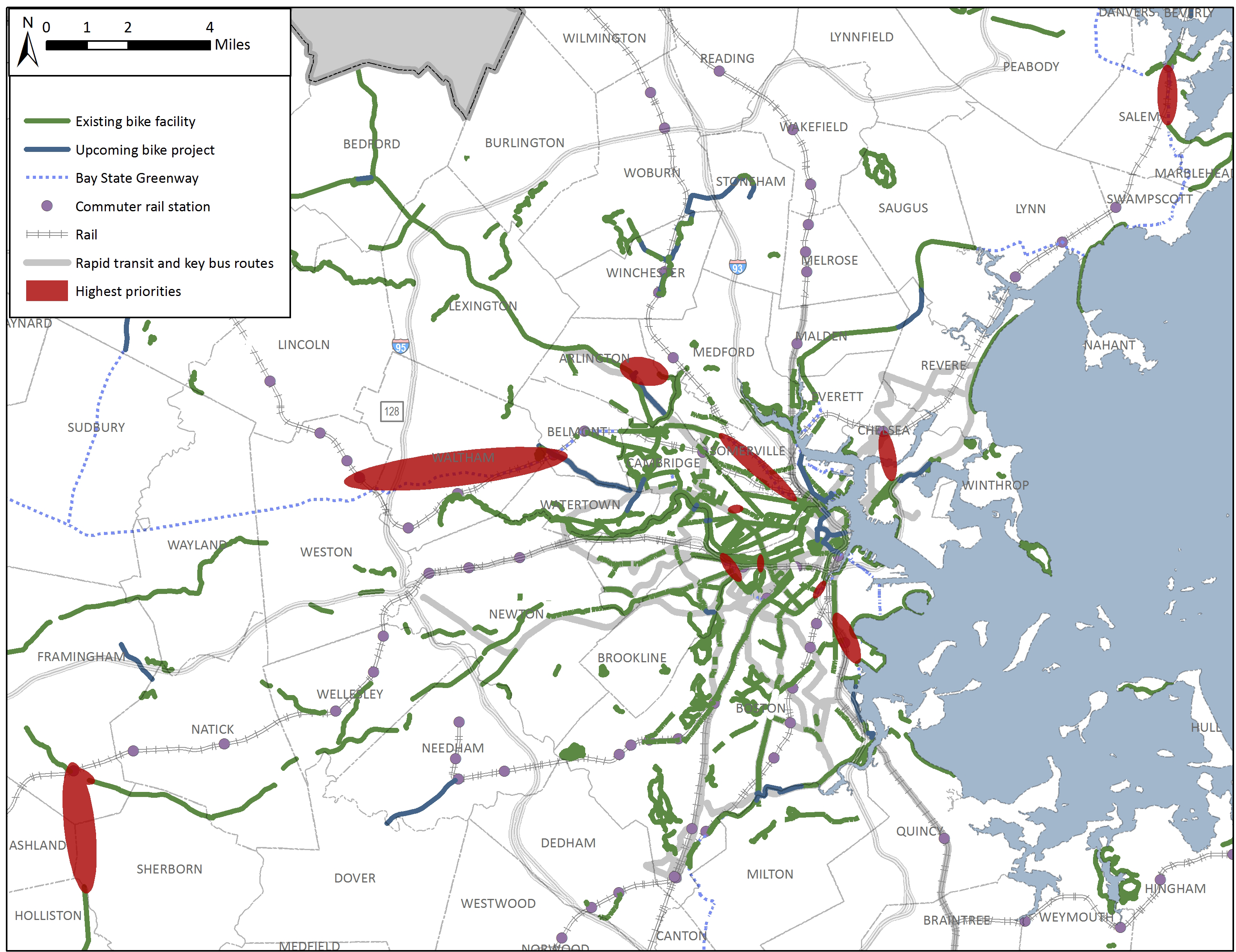
Please give us your feedback!
- What are the region’s transportation needs?
- Where are the most dangerous intersections, corridors, and interchanges?
- Where is the most severe congestion?
- Where are there gaps in the walking, biking, and transit network?
- What needs are most important to address?
3 SCENARIO PLANNING PROCESS
Scenario planning for developing this LRTP helped both the MPO and the public weigh the benefits and tradeoffs of a variety of investment strategies. The MPO examined how allocating available dollars to various strategies would best address the identified transportation needs of the region, while advancing the MPO’s vision, goals, and objectives.
Using the inputs shown in the figure below, staff crafted three scenarios of alternative investment strategies for the MPO to review. Staff then analyzed the effects these scenarios would have on a selection of transportation-related indicators. Using the results of this scenario planning, the MPO identified the recommended investment strategy for the final LRTP.
Scenario planning will continue to be utilized throughout the MPO’s performance-based planning and programming process, to update the region’s land use plan, and to plan individual transportation projects.
Inputs into the Development of the LRTP
Summary of Recent Investments
Looking at past MPO investments is useful when considering how money should be spent in the future. Recent MPO investments have been guided by the MPO’s current goals of providing a transportation system that is well maintained, improves mobility for people and freight, and provides safe transportation for all modes. To advance these goals, the MPO conducted studies and funded the construction of infrastructure projects. Below are examples of recent investments made in the Boston region.
Corridor investments that help to reduce crash severity, increase healthy transportation options, and reduce delay for all users.
Locations Studied:
- Routes 127/127A in Rockport and Gloucester (2014)
- Route 114 (I-95 to Peabody) in Danvers (2012)
- Route 203 (Gallivan Boulevard and Morton Street) in Boston (2012)
- Route 3A in Cohasset and Scituate (Henry Turner Bailey Road in Scituate to Commuter Rail Station in Cohasset) (2014)
- Route 30 in Framingham and Natick (2013)
- Route 126 from Bellingham to Framingham (2011)
- Route 2 (Concord Rotary through I-95, excluding Crosby’s Corner) in Concord and Lincoln (2013)
Projects:
- Reconstruction of Route 85 in Hudson (2011)
- Route 139 Corridor Improvements in Marshfield (2011)
- Reconstruction of Trapelo Road and Belmont Street in Watertown and Belmont (2012)
- Reconstruction of Route 129 (Broadway) in Lynn (2013)
- Reconstruction of West Street in Reading (2014)
- Reconstruction and Signal Improvements on Rantoul Street (Route 1A) in Beverly (2014)
Intersection investments that help to reduce crash severity and reduce delay for all users.
Locations Studied:
- Intersection of Humphrey St., Burrill St., and Monument Ave. in Swampscott (2012)
- Western Ave (Route 107) at Washington Street (Route 129) in Lynn (2013)
- Massachusetts Avenue at Appleton Street and Appleton Place in Arlington (2011)
- Main Street (Route 38/129) at Church Street/Burlington Avenue (Route 62) in Wilmington (2012)
- Franklin Street (Route 37) at West Street and Granite Street in Braintree (2013)
- North/South Franklin Street (Route 37) at Union Street/Plymouth Street (Route 139) in Holbrook (2013)
- Neponset Valley Parkway at Brush Hill Road and Milton Street in Milton (2011)
- Turnpike Road (Route 9) at Central Street/Oak Hill Road in Southborough (2012)
- Union Avenue at Mt. Wayte Avenue in Framingham (2011)
- Lincoln Street at Cox Street/Packard Street in Hudson (2011)
- Main Street (Route 117) at Still River Road (Route 110) in Bolton (2010)
- Central Street at Pearl Street in Stoughton (2010)
Projects:
- Route 2A and Waltham Street in Lexington (2010)
- Route 16 Intersection Improvements in Milford (2011)
- Intersection Improvements at Route 9 and Oak Street in Natick (2012)
- Intersection & Signal Improvements at Hancock Street and East/West Squantum Streets in Quincy (2014)
Bicycle investments that help to close gaps between existing facilities and expand access to transit stations, downtown centers, and schools.
Locations Studied:
- Danvers Rail Trail Crossing at Route 62/Poplar Street (2012)
- Glendale Square (Ferry Street and Elm Street) in Everett (2013)
- Oak Grove Station in Malden (2012)
- Braintree Station in Braintree (2012)
- Franklin Town Center (2010)
Projects:
- Upper Charles Trail, Phase 2 in Milford (2009)
- Somerville Community Path (2012)
- Bikeway Connection at Intersection of Route 3 and Route 60 in Arlington (2014)
- Tri-Community Bikeway in Winchester, Stoneham, and Woburn (2015)
Interchange investments that help to reduce crash severity and delay for motorists.
Locations Studied:
- I-95 southbound, at the off-ramp area of Interchange 32B in Burlington (2012)
- I-93/Southeast Expressway/Route 3 (Braintree Split) (2006)
- I-90 Interchange 17 (Newton Corner Rotary) (2007 and 2009)
- I-93/Route 24 Interchange; study area included parts of Randolph, Stoughton, and Canton (2007)
Projects:
- Interchange Improvements along Route 128 at Route 35 and Route 62 in Danvers (2010)
- Route 128 Improvement Program in Randolph (Contracts III, IV and V) in Randolph, Canton, Westwood, Dedham, Needham and Wellesley (2008-18)
- Route 2 (Crosby’s Corner) in Concord and Lincoln (2011-14)
Transit investments to increase transit usage and improve access and accessibility for all customers.
Locations Studied:
- SWAP Regional Public Transit Feasibility Study (2013)
- Evaluation of MetroWest Regional Transit Authority Fixed Route Network (2009; additional transit planning assistance in 2013)
- Assessment of Dudley South Corridor Bus Service and Potential Improvements (2009)
Projects:
- Assembly Square Station in Somerville (2011)
- Green Line Extension Project, Phase II in Somerville and Medford (2016-18)
Projects Funded with TIP Target Program Funding
(Fereral Fiscal Years 2008-18)
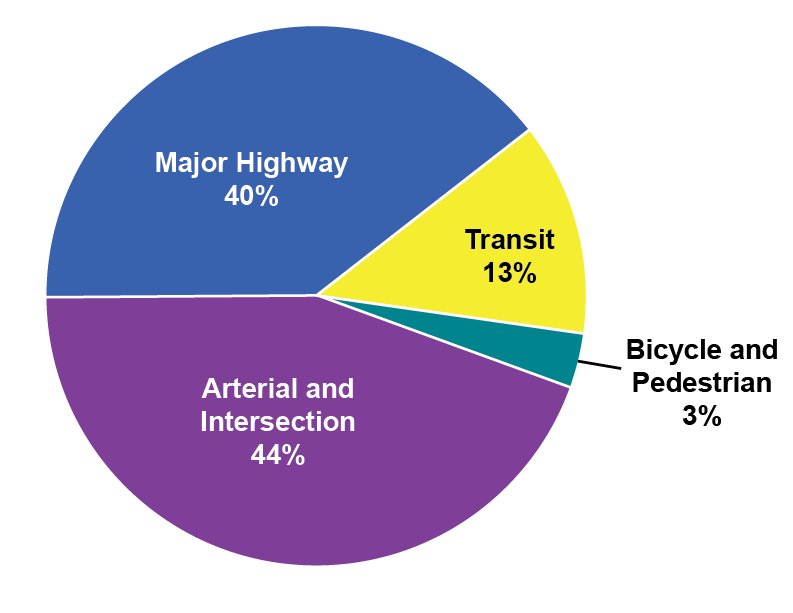
Sum of Projects Funded: $730 million
Note: Arterial and Intersection investments include bicycle and pedestrian components of Complete Streets projects. The transit portion reflects highway funding that has been flexed for transit projects.
Transit Projects
- Reduce more than 2200 tons of CO2 annually
- Improve transit access and transit service for areas of Somerville and Medford
- Support development of new housing units, retail and office space
- Launch GATRA transit service in Marshfield, Duxbury, and Franklin
- Support rail shuttle service in Acton
Arterial and Intersection Projects
- Reduce more than 3600 tons of CO2 annually
- Resurface approximately 95 lane miles of pavement
- Add 45 miles of bicycle lanes
- Improve 38 miles of sidewalks
- Add 32 miles of new sidewalks
- Serve more than 41 bus routes
- Improve access to 13 transit stations
- Improve safety at 5 high crash locations
- Address 2 bottleneck locations
- Add more than 10 miles of new roadway capacity
Bicycle and Pedestrian Projects
- Add more than 11 miles to the bicycle network
- Support launch of Hubway in Boston, Cambridge and Brookline
- Improve safety at one of the top 200 crash locations
- Facilitate hundreds/thousands of daily walking and bicycling trips
- Provide access to transit stations, schools, recreation and commercial areas
Major Highway Projects
- Improve safety at one of the top 200 crash locations and multiple interchanges
- Address a major bottleneck location
- Add travel lanes and shoulders along 3 miles of Route 128
Future Investment Program
In the future, MPO investments will continue to be guided by MPO goals. In turn, these goals will guide prioritization of infrastructure projects funded through the TIP. Given that the MPO does not have enough funding to address all necessary investments, the MPO weighed the tradeoffs of different strategies before allocating resources. One of the MPO’s investment strategies involved establishing programs in the LRTP that advance multiple goals. Listed below are programs that were included in the LRTP and TIP, along with examples of candidate projects drawn from the TIP Universe of Projects or other planning documents.
An intersection program to reduce crash severity and reduce delay for all users
Goals Addressed: Safety; System Preservation; Capacity Management/Mobility;Clean Air/Clean Communities
Possible Projects:
- Intersection Improvements at Middle Street, Libbey Industrial Parkway and Tara Drive in Weymouth*
- Traffic Signal Improvements at 11 Locations in Boston*
- Intersection Improvements at Weymouth Street/Pine Street/Sycamore Street in Holbrook
- Route 20 at Concord Road in Marlborough
- Intersection & Signal Improvements at Route 30 and Wellesley in Weston
- Intersection Improvements at Route 1 and University Avenue in Norwood
A Complete Streets program to increase multi-modal transportation options and reduce delay.
Goals Addressed: Safety; System Preservation; Capacity Management/Mobility
Possible Projects:
- Reconstruction of Highland Avenue/Needham Street in Newton and Needham*
- Reconstruction on Massachusetts Avenue in Lexington*
- Reconstruction of Route 27 (Main Street) in Natick*
- Signal and Intersection Improvements on Route 135 in Hopkinton*
- Reconstruction of Ferry Street in Everett*
- Improvements on Boylston Street in Boston*
- Reconstruction on Route 1A (Main Street) in Walpole*
A bike network program to increase healthy transportation options, enhance connectivity and improve safety.
Goals Addressed: Safety; Capacity Management/Mobility; Clean Air/Clean Communities
Possible Projects:
- Multi-use Path Construction on New Fenway in Boston*
- Cochituate Rail Trail, Phase Two in Natick*
- Minuteman Bikeway Extension in Bedford
- Emerald Necklace Crossing at Route 9 in Brookline
- Canal Street Bikeway in Salem
- Extension of the Upper Charles Trail in Holliston
- Assabet River Rail Trail in Stow
- Woburn Loop Bikeway
A pedestrian connections program to improve safety and increase healthy transportation options.
Goals Addressed: Safety; Capacity Management/Mobility; Clean Air/Clean Communities
Possible Projects:
- Pedestrian Improvements along Elm Street and Rustcraft Road in Dedham
- Pedestrian Improvements along Bussey Street in Dedham
A transit program to preserve the system and increase healthy transportation options, which could consist of state of good repair needs not included in the MBTA’s Capital Investment Program or system expansion projects listed in the current Program for Mass Transportation or proposed Focus 40 Plan.
Goals Addressed: Capacity Management/Mobility; Transportation Equity; Other goals depending on the project
A major infrastructure program for major modernization or expansion projects that impact regional travel.
Goals Addressed: Safety; System Preservation; Capacity Management/Mobility; Economic Vitality
Possible Projects:
- Woburn – Interchange Improvements to I-93/I-95
- Boston – Reconstruction of Rutherford Avenue**
- Malden, Revere and Saugus – Reconstruction and Widening on Route 1
- Framingham – Intersection Improvements at Route 126/135/MBTA and CSX Railroad**
- Braintree – I-93/Route 3 Interchange (Braintree Split)
- Concord – Improvements and Upgrades to Concord Rotary
- Marlborough and Hudson – I-495/I-290/Route 85 Interchange
- Somerville – McCarthy Boulevard Construction**
Potential Programs for Future Consideration
A bottlenecks program to address congested highway and arterial locations.
Goals Addressed: Capacity Management/Mobility; Safety; Economic Vitality
Possible Projects:
- Mainline Improvements on Route 128 (Phase II) in Peabody
- Construction of I-495/Route 1A Ramps in Wrentham
An interchange modernization program to modernize outdated interchanges in the system to improve safety and reduce congestion.
Goals Addressed: Safety; System Preservation; Capacity Management/Mobility; Economic Vitality
Possible Projects:
- Natick – Route 27 over Route 9 Interchange Improvements**
- Saugus – Interchange Reconstruction at Walnut Street and Route 1
- Wrentham – Construction of I-495/Route 1A Ramps
- Beverly – Interchange Reconstruction at Route 128/Exit 19 at Brimbal Avenue (Phase II)
- Newton – Improvements of Route 128/I-95 and Grove Street
- Southborough and Westborough – Improvements at I-495 and Route 9
4 FINALIZING THE PLAN
Once the three LRTP development steps—establishing a vision, goal and objectives; identifying needs; and scenario planning—were completed, the MPO had many of the necessary inputs to develop a draft LRTP. Information about expected land use and transportation funding over the life of the plan also supported an MPO staff recommendation for a preferred transportation investment approach. After the MPO decided upon the preferred investment approach, staff conducted air-quality, greenhouse-gas, and transportation-equity analyses of the approach. Staff also developed supporting chapters on various aspects of the planning process and the selected investment approach that were included in the draft LRTP document. The MPO then approved a draft LRTP document for public review and comment, and MPO staff gathered this feedback. The MPO considered the public’s comments as it decided upon a final LRTP. The LRTP was endorsed at the end of July 2015.
The LRTP will shape all aspects of MPO planning. In particular, it will provide direction for the types of capital projects included in the TIP, and planning activities included in the UPWP. It also will lay the foundation for the MPO’s performance-based planning process, which the MPO will use to monitor progress toward achieving its goals and objectives.
Perfomance-Based Planning
Long-Range Transportation Plan Developement
Please give us your feedback!
- Are the region’s transportation priorities being addressed?
- How should the MPO’s prioritization of investments change in the future?
- What other types of studies, programs, and projects should the MPO consider?
* Funded in 2016-2020 TIP
** Funded in LRTP







